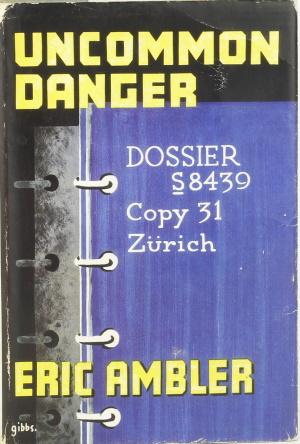 First edition cover
First edition cover
Book Review by George S: Kenton is a journalist taking a train from Berlin to Vienna. Sachs, a rather dubious stranger, persuades him to carry some documents through customs. When he goes to deliver them to the man’s hotel in Vienna, he finds him murdered.
This beginning, which reminded me of John Buchan’s The Thirty-Nine Steps, is a typical thriller set-up. The hero is on his own, pursued by the police as a suspect for the murder, and also by the bad people who are after the documents that he still possesses. He soon discovers, in fact, that the documents (a set of photographs) are wanted not only by a ruthless set of businessmen, but also by the Russian government, who have sent agents to capture them at any cost. He is plunged into an adventure of car chases, risky border crossings, gunfights, kidnappings and torture. The book is a tremendously exciting read, as it takes us through the unpleasant complexities of thirties Europe, and shows the violent realities under the surface of business and politics.
One end of the game was being played in the rarefied atmosphere of board-rooms and shooting- parties; the other was played, with persons like Sachs as counters, in trains, in cheap hotels,in suburbs of big cities, in murky places away from the bright highways dedicated to the rosy-cheeked goddess of tourisme.
Having been reminded of the Thirty-Nine Steps, I started thinking about how this thriller differed from those of the twenties, by Buchan, ‘Sapper’, Dornford Yates and others. The main difference is the hero. Richard Hannay, Bulldog Drummond and Jonah Mansel are typically ex-soldiers, deploying the righteous violence they used in war to solve the problems of peacetime. They display virtues that are presented as solidly British (and Hannay is all the more British for being a colonial) and their moral probity is never doubted by their authors (though some readers might have reservations).
Ambler’s Kenton is a different matter. He is a journalist without very fixed principles. He is making the journey to Vienna because he has lost all his money gambling, and he carries the lethal documents only because he has been bribed to do so. This makes him a more interesting hero than the likes of Bulldog Drummond, because Ambler can show him growing in moral strength by facing the challenges presented to him. In particular, when captured by the agents of the vile businessmen, the threat of torture brings out qualities he did not know he possessed:
Then, rather to his surprise, he became conscious of a new and unfamiliar sensation. For the first time in his adult life someone was trying to coerce him with threats into making a decision, and his mind was reacting with cold, angry, obstinate refusal.
The fact that Kenton is something of an anti-hero makes it possible for the character to develop during the course of the adventure – unlike Hannay and Bulldog Drummond, who embody their author’s ideals from the start, and are just the same at the end of the book as they were at the beginning.
Another difference between this thriller and the earlier ones is the treatment of the Russians. In books like Sapper’s The Black Gang, the Bolsheviks are definitely among the villains, creating social disorder through strikes, or sometimes they are presented as the dupes of the villains. I’ve always liked this sentence from Agatha Christie’s The Secret Adversary (1922; written before she had established her characteristic format, and owing a great deal to Bulldog Drummond): ‘The Bolshevists are behind the labor unrest – but this man is behind the Bolshevists’.
In Uncommon Danger, however, the Russian communist agent Zaleshoff is a much more complex proposition. Utterly ruthless, and responsible for more than one murder, he is presented as more principled than the agents of big business who are the book’s primary villains. He saves Kenton’s life, and the two are thrown into an alliance that is at first very uneasy but becomes increasingly firm. This reflects a thirties view of the Russian communists as ethically dubious, but a possible bulwark against darker forces of fascism.
Whereas those simpler thrillers of the twenties usually presented the British as dogged, principled heroes, and most foreigners as morally dubious, Ambler offers a less comforting read for his English audience. The novel’s prologue shows the plot being set in motion in the board meeting of a London company. The businessmen there are motivated only by their own desire for money, and their greed sets in motion events that threaten the stability of Europe.
There is even less comfort for the English in Ambler’s choice of his most unpleasant villain. Captain Mailler, we are told, had been one of the Black and Tans, the paramilitary force made up of mostly English ex-soldiers, whose ruthless behavior in Ireland had done much to exacerbate the Troubles. Mailler is an expert at torture, and uses a rubber truncheon (a favorite weapon of Mussolini’s Blackshirts) with sadistic expertise. As he begins to beat up Kenton, his eyes glaze with ‘a glare of animal ferocity’ and ‘there was a slight white froth in the corners of his mouth’. This villain is an uncomfortable reminder of a less than savoury episode in recent British history.
In short, this novel is a more grown-up affair than the thrillers of Buchan and Sapper, for all that it uses the same conventions. It does, however, have some of the same implausibilities. The chief villain, like the baddies of the earlier books, still makes the basic mistake of not killing the hero with one bullet when he has a chance. Instead he prefers to leave Kenton and Zaharoff to die a lingering death together in a tank that is gradually running out of oxygen. How they get out of this situation is well worth reading.
As indeed is the whole book. Highly recommended.
